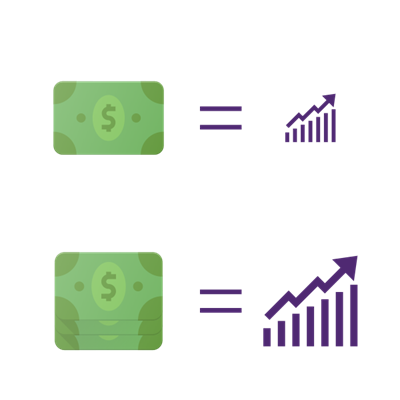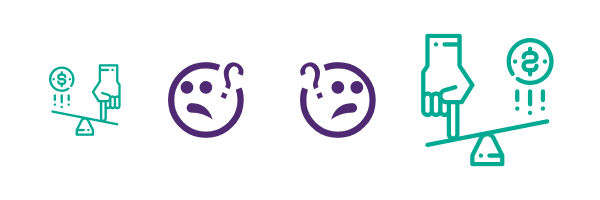Trading requires larger deposits
Forex leverage is one of the most popular features among traders who want to have larger trading positions. And the reason is simple: the larger the
position size, the bigger the payouts.
In fact, if a trader wants to withdraw, say, $2,000 every month from their account, they probably need to have a position size from $50,000 to $100,000 which will regularly generate payouts. And if a month is not so successful, there will be fewer funds to withdraw.
In general, only 1-3% of the returns (payouts) are usually dedicated for withdrawal purposes. That means that just a $100,000 position size isn’t sufficient; a trader needs to actually generate payouts then to withdraw them.

Obviously, $100,000 is a pretty significant sum of money and it is not easy to have a position size that large. But without that, traders are rarely able to get sufficient funds on a monthly basis. However, we are not saying that traders completely stay away from trading or don’t get enough income from Forex, commodities, or other types of trading.
Brokers also realize that this is a serious problem and many traders cannot afford larger deposits.
-That is why they offer them loans, so to say. With loans, traders are able to increase their position size and get higher payouts as a result.
What is leverage in trading?
Leverage is often referred to as a loan sometimes. The leverage for Forex tends to go as high as 1:100, 1:200, and more, whereas other markets usually have smaller ones. So, traders can use the leverage to increase their trading position sizes by a significant amount. This, in turn, allows them to get certain benefits:
- Increased payouts
- Increased capital efficiency
- Softened effects of low volatility
Let’s take a look at each of these advantages.
Increased payouts
The first and probably the most important reason why people use leverage is that it increases the possible payouts. Here is an example of leverage in Forex trading: let’s say you bought EUR/USD currency pair for $1,000 at the price of 1.21 (selling price). This means that you bought around 826 euros with your capital.
However, if you were to use the leverage trade at a rate of 1:200, you would be able to get that same amount of payout in a much shorter time - even one day could be enough for that. This means two things: one, you would have much less work to do.
But more importantly, you would be able to return that $200 back into trading much more frequently. This way, your capital could increase at a faster rate, allowing you to trade more intensively and get even higher payouts.
Mitigated impacts of low volatility with leverage in trading
When it comes to trading on a foreign exchange market, there is one thing to keep in mind: the most popular currency pairs like EUR/USD, GBP/USD, and others are more or less stable. This means that the volatility - the speed at which prices are changing - is quite low.
As you might already know, one of the main reasons why trading generates payouts is volatility: a quick change in price allows traders to buy an asset when it’s cheap and sell it when it becomes expensive. Since many popular currency pairs can be low on volatility, it is difficult to generate considerable payouts.
This is where leverage comes in. Because traders now control much larger position sizes, they purchase even more currency pairs and that minimum difference suddenly becomes significant. The same example of $8 and $1,600 can be used for demonstration purposes.
Forex leverage and margin explained
Now, when we talk about leverage and leveraged deposits, we also need to mention what lies behind this tool. When service providers are lending funds to the traders in order to leverage higher position sizes, it might seem to many people that they do so without any insurance; that they entrust their funds with their clients.

But that is not what happens in real life. Instead, providers demand their clients to deposit a certain amount of money to their account. This is called
a margin and is depicted in percentages.
Here is another example: if a broker provides a leveraged position size of $100,000 and its margin is 2%, it means that a trader must make a deposit of $2,000 with their own money. This way, a broker will lock up those funds in exchange for opening a large position size.
What size of leverage to use in trading?
Up to this point, it may seem to a reader that the leverage is a universal tool that can be applied to any type of trading with high rates and result in even higher payouts. However, different trading strategies tend to require different types of leverage amounts as well.

For example, “scalpers” might use larger leverage rates in general. This is a group of traders who prefer short-term trading operations and usually enter the market several times a day. For them, a higher leverage rate tends to be more beneficial because the smallest change in asset price can be increased by the leveraged position sizes.
On the other hand, there are the so-called “position traders” who employ a completely opposite strategy. This is a group of traders who hold their assets; be it currencies, stocks, or anything else, for an extended amount of time. They expect that the longer they wait, the larger the price will get. And for them, lower leverage is usually a more suitable option. That’s because the short-term price changes can go so low that the leveraged losses are larger than the deposited funds, at which points traders are forced out from the operation.
In general, if a trader has short-term trading operations and expects to receive payouts in a short time, they usually use higher leverage. When the position times become longer, days, weeks, or even months, traders tend to employ lower leverage.
Watch out for a leverage risk!
As a final point, it is also important to mention some of the disadvantages of leverage because it’s not a totally positive tool. On the one hand, it definitely increases the possible payout sizes and also has other benefits we listed above. On the other hand, however, it also increases the losses that are expected from every trade.
Imagine the same example we took a bit earlier, where instead of $8 you earned $1,600 because of leverage. Now imagine that instead of the increase in a EUR/USD price, it actually reduced from 1.20/1.21 to 1.18/1.19. In regular circumstances, you would be able to sell your 826 euros for almost $991, and while you would still lose $9 in total, it wouldn’t be something too damaging.
However, if you used the same leverage of 1:200, the losses would be even more serious. In fact, the initial $9 multiplied by 200 is $1,800. So, while it’s beneficial to go from $8 to $1,600 in payouts, it’s equally - and often even more - damaging to go from $9 to $1,800 in losses. Therefore, traders need to use this tool very carefully.
